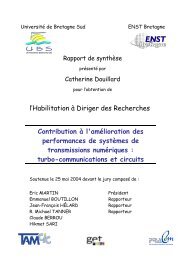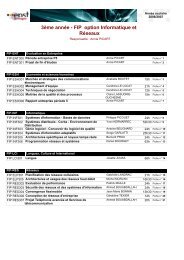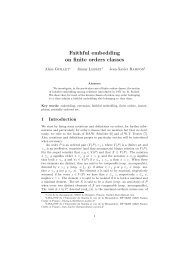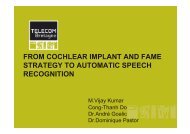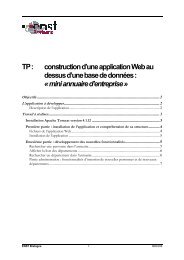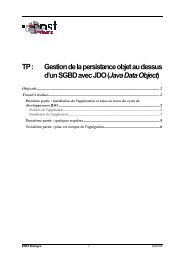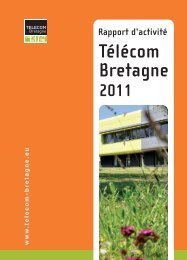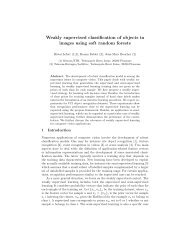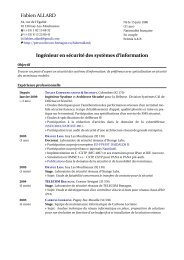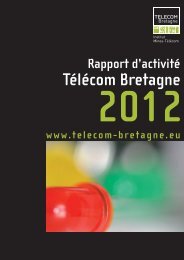researResearch - Télécom Bretagne
researResearch - Télécom Bretagne
researResearch - Télécom Bretagne
Create successful ePaper yourself
Turn your PDF publications into a flip-book with our unique Google optimized e-Paper software.
h Research<br />
9<br />
RESEARCH<br />
Main achievements of the project<br />
Underwater seismic reflection<br />
Radar activity<br />
The project is carried out in accordance with<br />
previous research methods, such as the lateral<br />
continuity of reflectors in the case of submarine<br />
seismic images and the use of texture attributes<br />
for the identification of seismic properties. The<br />
use of active contours has been introduced to<br />
localize seismic salient features. Generalized<br />
cumulative entropy properties have been studied<br />
and its use as a new texture attribute as been<br />
tested.<br />
Classification<br />
As far as classification is considered, a new<br />
project concerns the development of weakly<br />
supervised segmentation methods applied to<br />
fishing. Two studies have been carried out: one is<br />
devoted to the production of large scale<br />
cartography including sonar images of a whole<br />
region, as well as occasional samples obtained<br />
from trawling. The second one concerns the<br />
characterization of mixtures of fish species on the<br />
sonar images.<br />
Weakly supervised learning algorithms, using as<br />
information the proportion of species (Bayesian<br />
method, SVM and SVM +Kernel) have been<br />
adapted to the case of images coming from a<br />
halieutics depth sounder. To compensate for the<br />
absence of « real-life field» data, we generated<br />
synthetic data to test our algorithms. We<br />
performed this task by making use of software<br />
developed by IFREMER. Several methods were<br />
tested to assess the abundance of species in a<br />
given geographical location from the observation<br />
of acoustic images at this location, with only the<br />
prior knowledge resulting from trawling at<br />
geographically neighbouring points.<br />
Another project is intended to classify signals<br />
issued from electric motors on vessels to improve<br />
preventive maintenance. After a comparison of<br />
several classification methods the SVM method<br />
was selected to classify electric motors and the<br />
classifier was optimised on the basis of provided<br />
data.<br />
A significant part of the activity has been devoted<br />
to radar waveforms design. Global optimisation<br />
methods, such as simulated annealing, have been<br />
considered for designing pseudo-random binary<br />
sequences with low level of sidelobes of the<br />
ambiguity function. The results obtained show the<br />
usefulness of these techniques whose<br />
performance remains nevertheless limited given<br />
the significant rejection requirements of these<br />
lobes in many radar applications.<br />
Spherical codes have been considered as a<br />
technique for the generation of waveforms.<br />
Standard pseudo-random sequences based on<br />
Galois fields have also been considered. The study<br />
and implementation of binary and polyphase<br />
Golay sequences has been carried out: we have<br />
shown that it is easy to extract Golay sequences<br />
presenting highly efficient ambiguity functions.<br />
We are currently investigating<br />
FMCW like waveforms have been studied for low<br />
cost car ACC (Automatic Cruise Control) radars<br />
development. Matlab software, including radar<br />
radiolink budget, RF transmitter/receiver<br />
characteristics integration and targets detection<br />
strategies has been developed. Comparisons with<br />
ADS simulations have been conducted showing<br />
the good behaviour of both platforms. This work<br />
has been done together with the microwave<br />
department of Télécom <strong>Bretagne</strong>. The study of<br />
waveform properties in relation with their<br />
parameter estimation variance performance has<br />
also been studied. Given the over-optimistic<br />
results provided by Cramer-Rao bounds,<br />
Barankin bounds are considered as performance<br />
indicators. These results have been used to justify<br />
practical choice of detection threshold in ACC<br />
radars.<br />
A robust detector for the detection of small<br />
objects in sea clutter has been proposed and we<br />
have developed a radar image filter associating<br />
wavelets and MAP filtering.<br />
191



